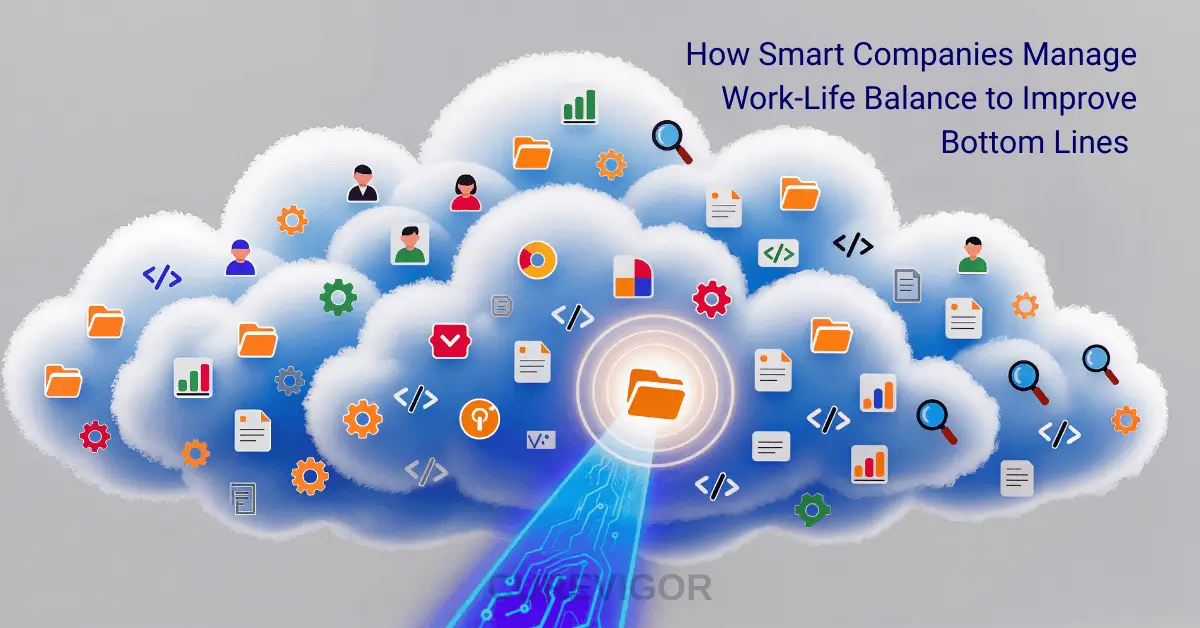Boost your bottom line by learning to effectively manage work-life balance. Explore flexible work arrangements, wellness programs, and leadership tactics that improve performance and employee loyalty.
Thank you for reading this post, don't forget to subscribe!- The era of burnout is over; the smartest companies are now leveraging work-life balance as a powerful engine for profit and growth.
- Forget the free snacks and ping-pong tables—the real secret to a high-performing, loyal workforce is a genuine commitment to work-life balance.
- The era of burnout is over; the smartest companies are now leveraging work-life balance as a powerful engine for profit and growth.
- Forget the free snacks and ping-pong tables—the real secret to a high-performing, loyal workforce is a genuine commitment to work-life balance.
For decades, work-life balance was a soft topic. It was a “nice-to-have” perk discussed in HR seminars. Today, that perception is obsolete. Forward-thinking executives now recognize a powerful truth.
How Smart Companies Manage Work-Life Balance to Improve Bottom Lines
Actively helping employees manage work-life balance is not just an employee benefit; it is a key part of the employee experience. It is a core business strategy with a direct, measurable impact on profitability.
The old model of burnout and endless hustle is breaking. It is being replaced by a new paradigm. In this paradigm, employee well-being and corporate success are two sides of the same coin.
Companies that cling to outdated practices see their best talent walk out the door. They face rising healthcare costs and plummeting productivity.

Smart companies are choosing a different path. They are building cultures where people can thrive both in and out of the office.
They understand that a rested, valued, and engaged employee is productive, innovative, and loyal.
This blog post will explore the compelling business case for this shift. We will reveal the concrete strategies these companies use. You will learn how to measure the return on investment.
Let’s dive into how you can transform your organization by learning to manage work-life balance effectively.
The Unbeatable Business Case for Work-Life Balance
Why should the C-suite care about work-life balance? The data speaks for itself. Companies that prioritize employee well-being do not just create happier workplaces; they also foster a culture of trust and collaboration.
They build more resilient and profitable businesses. The connection is clear and powerful.
Employee satisfaction is the cornerstone. When employees feel their personal time is respected, their job satisfaction soars. This satisfaction is the fuel for higher productivity.
A focused, energized employee accomplishes more in eight hours than a burned-out one does in ten. This directly enhances operational efficiency and output quality.
High employee retention is another critical financial benefit. The cost of replacing a single employee might range from half to twice their yearly compensation. These costs include recruitment, training, and lost productivity.
Companies with strong work-life cultures dramatically reduce this churn. They retain institutional knowledge and keep their top performers.
Furthermore, a positive culture becomes a powerful recruitment tool. The best talent actively seeks employers who value their whole lives. This gives your company a competitive edge in the war for talent.
Ultimately, all these factors converge to drive sustained business success. Investing in balance is not an expense. It is an investment in your most valuable asset: your people.
Powerful Strategies to Manage Work-Life Balance
Understanding the “why” is essential. But implementing the “how” is where transformation happens.
Successful companies deploy a multi-faceted approach. They use policies, programs, and a supportive culture to help employees manage work-life balance effectively.
Flexible Work Arrangements: The Key to Attaining and Keeping Top Talent
The traditional 9-to-5, in-office model is no longer the default. Flexibility is the new currency of the modern workplace. Offering flexible work arrangements is a fundamental way to manage work-life balance.
What does this look like in practice?
- Remote Work/Hybrid Models: Allow employees to work from home or other locations. This eliminates draining commutes. It gives employees control over their work environment.
- Flextime: Let employees select their start and end times within a set of core hours. This helps them manage school drop-offs, appointments, and personal commitments.
- Compressed Workweeks: Offer options like working four 10-hour days. This provides a three-day weekend, promoting deeper rest and recovery.
The business payoff is immense. You achieve access to a wider, more diverse talent pool. You are not limited by geography.
This flexibility is a powerful tool for employee retention. It shows trust and respect for your employees’ ability to manage their responsibilities. The result is a more engaged, motivated, and loyal workforce.
Employee Wellness Programs: Investing in Your Team’s Health and Well-being
A comprehensive wellness program shows you care about the whole person, not just the worker. It is a proactive strategy to manage work-life balance by supporting mental, physical, and financial health.
Modern wellness programs go beyond a gym membership. They include:
- Mental Health Support: Make counseling services available via an Employee Assistance Program (EAP). Offer subscriptions to meditation apps. Train managers to recognize signs of burnout.
- Fitness Initiatives: Sponsor gym memberships, organize company sports teams, or host virtual fitness challenges. Energy levels and mental well-being are inextricably related to physical health.
- Financial Wellness Resources: Offer workshops on budgeting, investing, and debt management. Financial stress is a major distraction at work. Alleviating it improves focus and productivity.
Investing in employee wellness reduces absenteeism and presenteeism (when employees are present but not productive).
It creates a healthier, more resilient organization. This directly lowers healthcare costs and strengthens your company’s bottom line.
Creating a Sustainable Culture of Work-Life Balance
Policies and programs are meaningless without a supportive culture. The most successful companies embed the principle of balance into their very DNA. They establish an atmosphere where workers feel comfortable utilizing the privileges provided to them.
Leading by Example: How Managers Set the Tone for Work-Life Balance
Culture trickles down from the top. If leaders send emails at midnight or brag about never taking a vacation, their teams will feel pressured to do the same. To truly manage work-life balance, leadership must model the behavior.
Effective leaders do the following:
- They use their own vacation time and fully disconnect.
- They set communication boundaries. For example, they avoid sending non-urgent emails after hours.
- They openly talk about their own hobbies and family time. This normalizes having a life outside of work.
- They encourage their teams to log off on time and take breaks.
When employees see their managers prioritizing self-care, they feel empowered to do the same. This creates an environment of trust and mutual respect.
It changes the emphasis from hours worked to outcomes produced. This leadership commitment is the engine of genuine cultural change.
Employee Resource Groups: Supporting Diverse Employee Needs
A one-size-fits-all approach does not work for work-life balance. The needs of a new parent are different from those of an employee caring for an aging parent. Employee Resource Groups (ERGs) are a powerful way to provide tailored support.
ERGs are employee-led groups. They form around shared characteristics or life experiences. For example, groups for working parents, women, or remote workers.
How do ERGs help manage work-life balance?
- They create a community of support. Employees can share tips and challenges with peers who understand.
- They provide valuable feedback to leadership. ERGs can identify unique work-life challenges facing different groups.
- They can advocate for specific policies. A parent’s ERG might successfully lobby for a more generous parental leave policy.
Businesses demonstrate their commitment to diversity by supporting ERGs. They recognize that their staff members handle work-life balance in a variety of ways.
Employee satisfaction rises, and the community becomes stronger and more cohesive.
Measuring the ROI of Your Efforts to Manage Work-Life Balance
For any business initiative, you must track results. How do you prove that your investment in work-life balance is paying off? You measure it.
Connecting your efforts to key performance indicators (KPIs) solidifies the business case and guides future strategy.
Metrics for Success: Tracking the Impact on Your Bottom Line
You cannot improve what you do not measure. To understand the effectiveness of your initiatives, monitor these critical metrics:
- Employee Retention & Turnover Rates: This is your most direct metric. A significant drop in voluntary turnover after implementing new policies is a clear win. Calculate the money saved from reduced recruitment and training costs.
- Employee Engagement & Satisfaction: Use regular pulse surveys and anonymous feedback tools. Track scores on questions related to work-life balance, managerial support, and overall employee satisfaction.
- Productivity Metrics: Look at project completion rates, sales figures, or output quality. Often, teams with better balance achieve more consistent, higher-quality results.
- Absenteeism: Track rates of unplanned absences. A decline often indicates better employee health and reduced burnout.
- Healthcare Costs: Over time, robust wellness programs can lead to lower company healthcare claims, especially in areas related to stress and mental health.
By analyzing these data points, you can build a compelling story. You can show a direct link between managing work-life balance and improved business success.
Case Studies: Companies That Have Mastered Work-Life Balance
Theory is good. Real-world proof is better. Let’s examine two companies renowned for their successful cultures.
Case Study 1: A Technology Giant’s Focus on Results

A leading software company has long been a pioneer in flexible work. They famously implemented a results-only work environment (ROWE).
In this model, employees are evaluated on output rather than hours spent in the office.
This radical trust empowers employees to manage work-life balance on their own terms. The result? They have consistently ranked high for employee satisfaction and innovation.
They have maintained a strong position in a fiercely competitive industry by attracting and retaining brilliant minds.
Case Study 2: An Outdoor Retailer’s Culture of Wellness

Patagonia, the outdoor clothing company, lives its values. They understand that their employees need to enjoy the outdoors to be passionate about their work.
They offer on-site childcare, flexible schedules, and even let employees go surfing when the waves are good. This deep commitment to well-being has created an incredibly loyal workforce.
Their low turnover and high brand advocacy are the envy of the retail world. They prove that a human-centric approach is a powerful business model.
Best Practices to Sustainably Manage Work-Life Balance
Implementation is an ongoing process. To make lasting change, embed these best practices into your daily operations.
Communicate Clearly: Setting Expectations and Healthy Boundaries
Ambiguity is the enemy of balance. Managers must set clear expectations about workloads, deadlines, and communication.
How to do this well:
- Define project priorities clearly. Help employees understand what is urgent and what can wait.
- Establish team norms for communication. For instance, agree that weekend emails are not expected.
- Encourage employees to use “out of office” notifications and set “do not disturb” hours on their communication apps.
- Have open conversations about workload. Create a safe space for employees to say they are at capacity.
Clear communication prevents burnout before it starts. It ensures everyone is aligned and reduces workplace stress. This is a foundational skill for any manager looking to manage work-life balance on their team.
Prioritize Self-Care: Encouraging Employees to Recharge Fully
A culture that glorifies overwork is unsustainable. Smart companies actively encourage employees to disconnect and recharge.

Turn encouragement into action:
- Mandate the use of vacation time. Some companies have even instituted mandatory company-wide shutdowns.
- Discourage “vacation shaming.” Never punish or subtly criticize an employee for taking time off.
- Promote the use of mental health days. Make it clear that sick days are for mental health, too.
- Leaders should share their own self-care practices. This normalizes the behavior.
When employees take real breaks, they return more creative, focused, and productive. Encouraging self-care is not coddling; it is a strategic move to maintain a high-performing team.
The Future is Balanced
The evidence is overwhelming. The companies that will lead the future are those that understand a simple equation: valued people create greater value.
Learning to effectively manage work-life balance is no longer a peripheral HR function. It is a central pillar of modern business strategy.
It drives employee satisfaction, boosts productivity, and ensures high employee retention. These factors combine to create a powerful engine for long-term business success.
The journey requires commitment. It demands a shift in leadership mindset and a willingness to trust employees.
Start today. Audit your current policies. Listen to your employees. Implement one new strategy.
The return on your investment will be a more resilient, innovative, and profitable organization. The future of work is balanced. Make sure your company is ready for it.
FAQs
Q. How can companies improve work-life balance?
Companies can improve work-life balance by moving beyond mere policies and fostering a supportive culture. This starts with implementing genuine flexible work arrangements, including remote options and adaptable hours.
They must invest in robust employee wellness programs that address mental and physical health. Crucially, leadership must model healthy behaviors by disconnecting after work and taking full vacations.
Establishing clear communication boundaries to prevent after-hours contact is also key.
Ultimately, it’s about trusting employees to manage their time and judging them on output, not hours logged.
Q. What is the 20 20 20 rule for work-life balance?
The 20 20 20 rule is a simple, structured framework designed to protect personal time and prevent burnout.
It suggests a clear division of the day: 20 hours for your professional work and career development, 20 hours for rest and sleep, and 20 hours for your personal life, hobbies, and family.
This model highlights the importance of dedicating equal time to recovery, personal fulfillment, and work.
While not always perfectly achievable, it serves as a powerful guideline for individuals to audit their time and ensure their lives outside of work are not consistently shortchanged.
Q. How does management support of employee work-life balance help the company’s bottom line?
Management support for work-life balance directly boosts the bottom line by enhancing key performance metrics.
When leaders model and encourage balance, employee satisfaction and loyalty soar, which dramatically reduces costly turnover and recruitment expenses.
It also leads to a significant increase in productivity, as well-rested employees are more focused, efficient, and make fewer errors.
Furthermore, it decreases absenteeism and presenteeism, lowering healthcare costs.
This creates a positive cycle where a healthier, more engaged workforce drives higher profitability and innovation.
Q. What is the healthiest shift to work?
The healthiest shift to work is typically the standard day shift, aligning most closely with our natural circadian rhythms.
This schedule allows for exposure to natural sunlight, supports regular sleep patterns, and facilitates social and family life.
Early morning shifts that start around 6 or 7 a.m. can also be healthy if they allow for an early finish to the day.
Shifts that severely disrupt the body’s internal clock, such as overnight or rotating schedules, are generally considered the least healthy due to their association with sleep disorders and long-term health risks.
Q. What is the 52 17 rule of productivity?
A time management strategy called the 52 17 rule is intended to increase concentration and avoid mental exhaustion.
It involves working with intense, undivided attention for 52 minutes, followed by a complete 17-minute break.
This method is rooted in the principle that the human brain works best in sprints rather than marathons. The extended break allows for genuine mental recovery, enabling you to return to your task refreshed and re-energized.
By structuring work this way, you can maintain a higher level of concentration and quality throughout the day.
Q. What is night shift syndrome?
“Night shift syndrome” is a colloquial term for the collection of health issues resulting from chronic circadian rhythm disruption.
It encompasses the physical and mental symptoms experienced by those who consistently work overnight.
Common effects include severe insomnia, digestive problems, a weakened immune system, and persistent fatigue.
Over the long term, it can increase the risk of more serious conditions like cardiovascular disease and metabolic disorders.
It’s a significant challenge because it forces the body to operate against its innate biological programming for sleep and wakefulness.
Q. The 10 4 3 2 1 rule: what is it?
The 10 4 3 2 1 rule is a simple formula for a healthier sleep routine and a more restful morning.
The numbers represent countdowns: 10 hours before bed, stop consuming caffeine, 4 hours before bed, avoid heavy meals or alcohol, 3 hours before bed, stop all work-related tasks, 2 hours before bed, stop using screens and electronic devices.
Finally, 1 hour before bed, set aside time for quiet activities like reading. This structured wind-down process helps signal to your body that it’s time to sleep, improving sleep quality and morning alertness.
Read more Health and Balance articles.
You might love:




